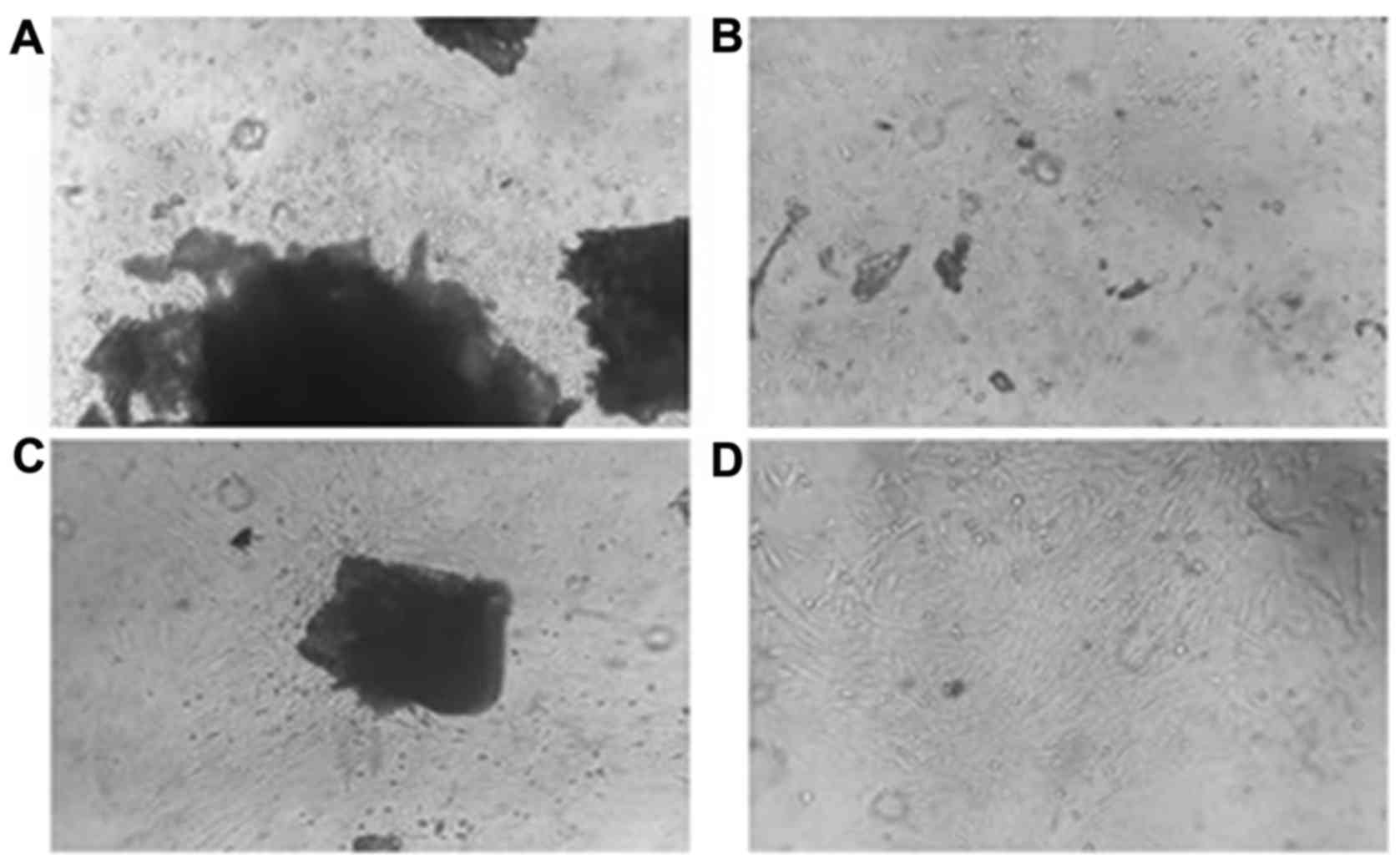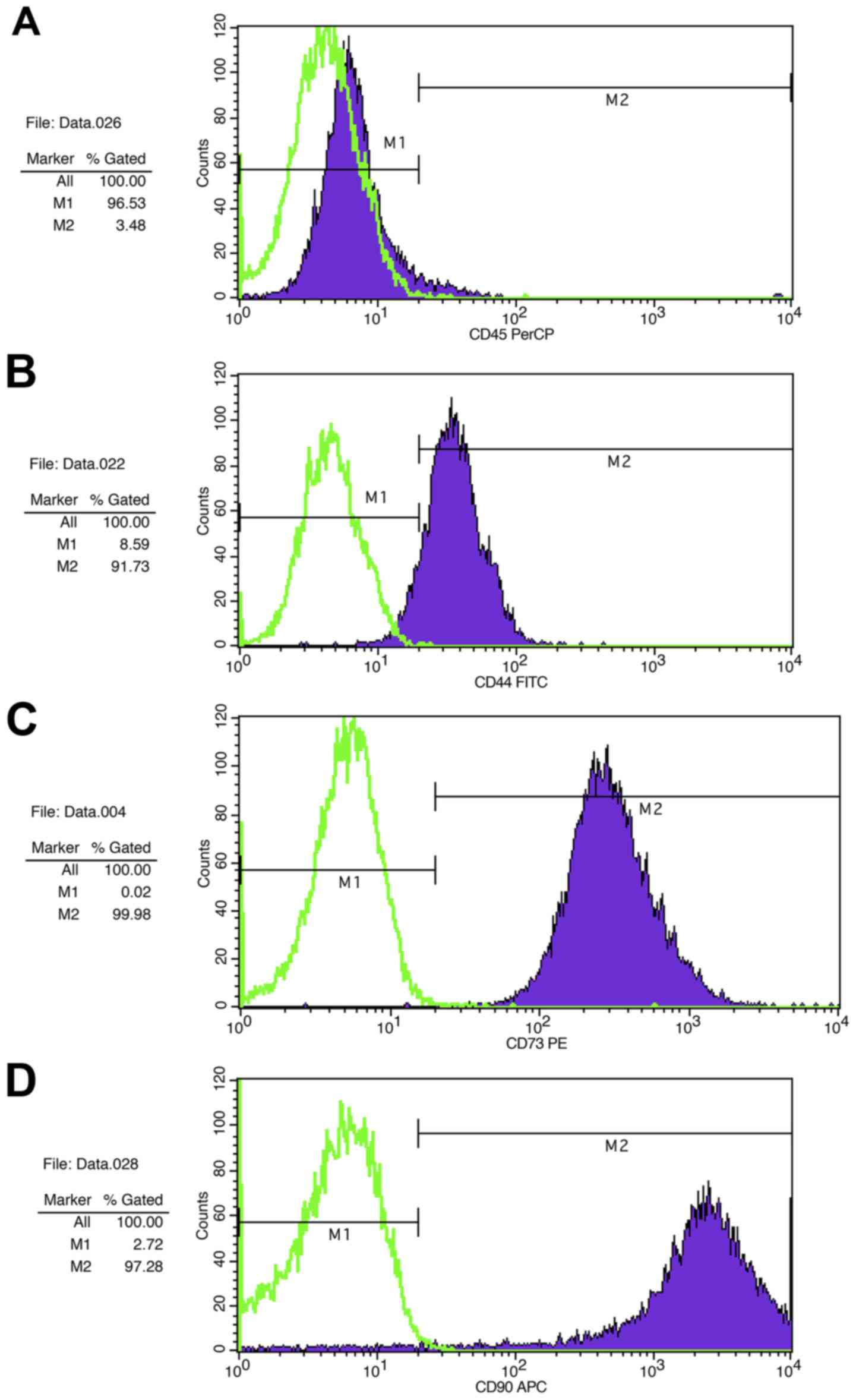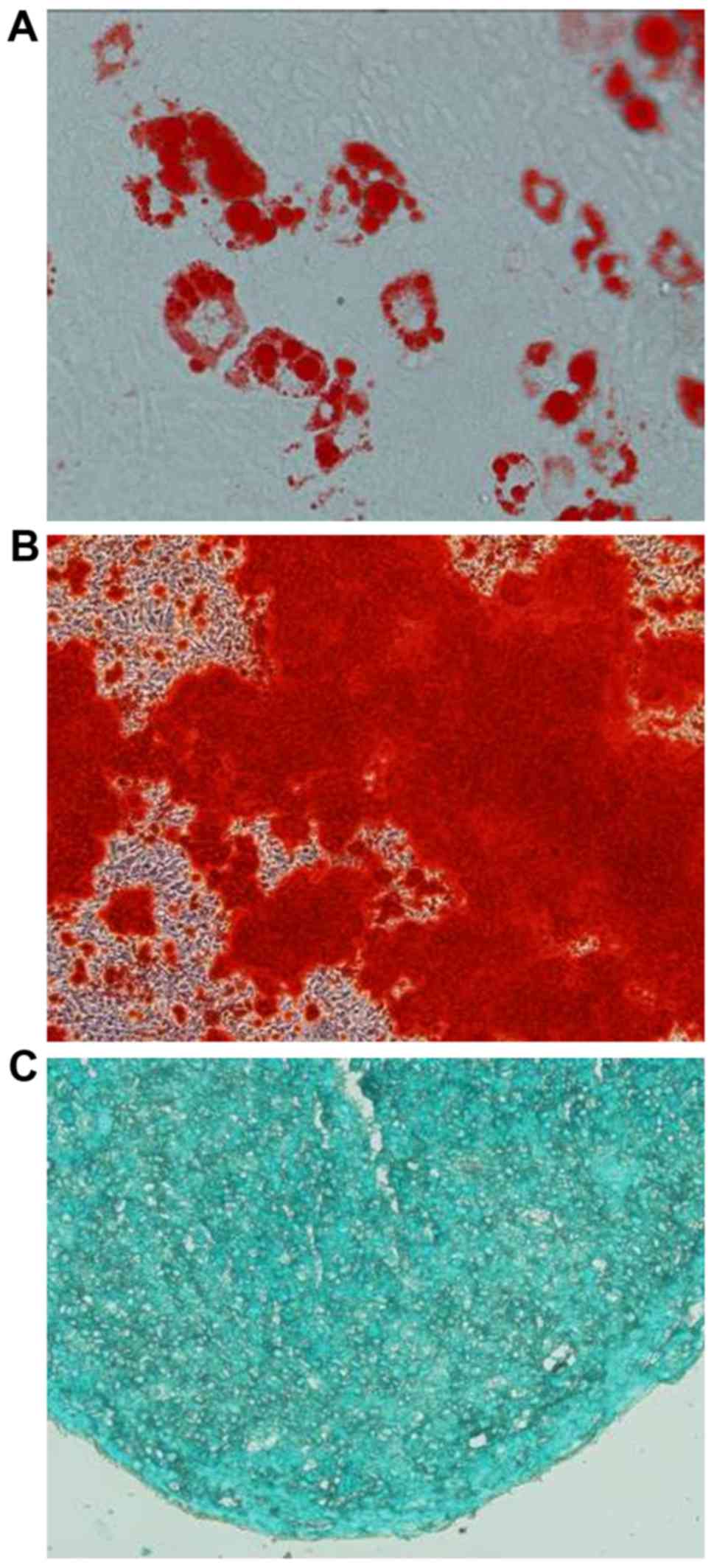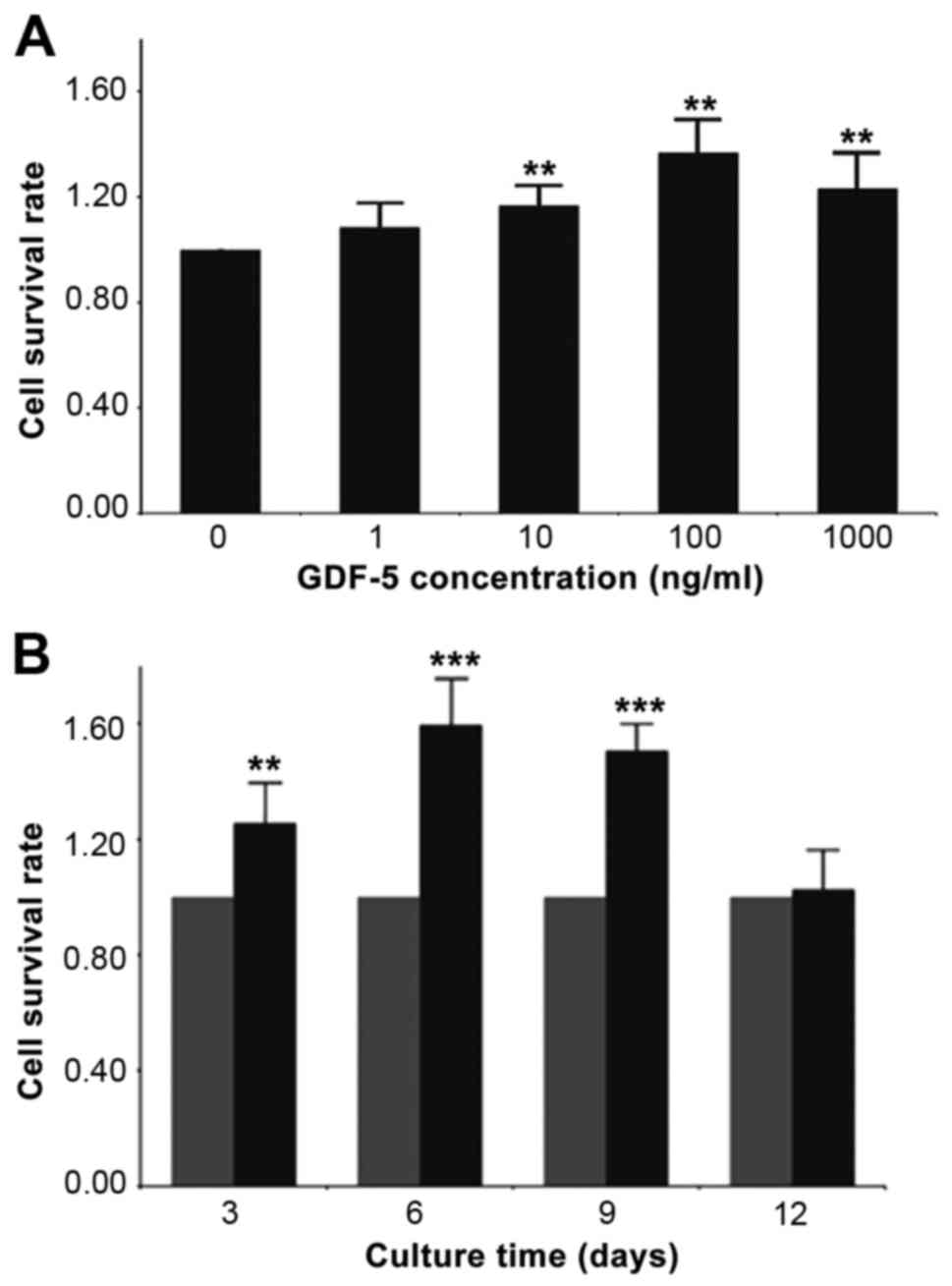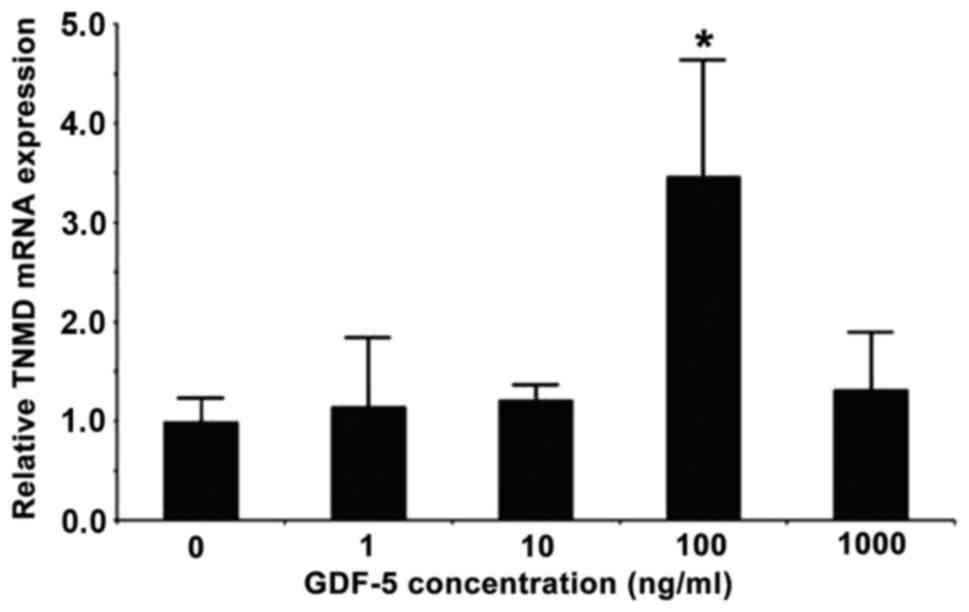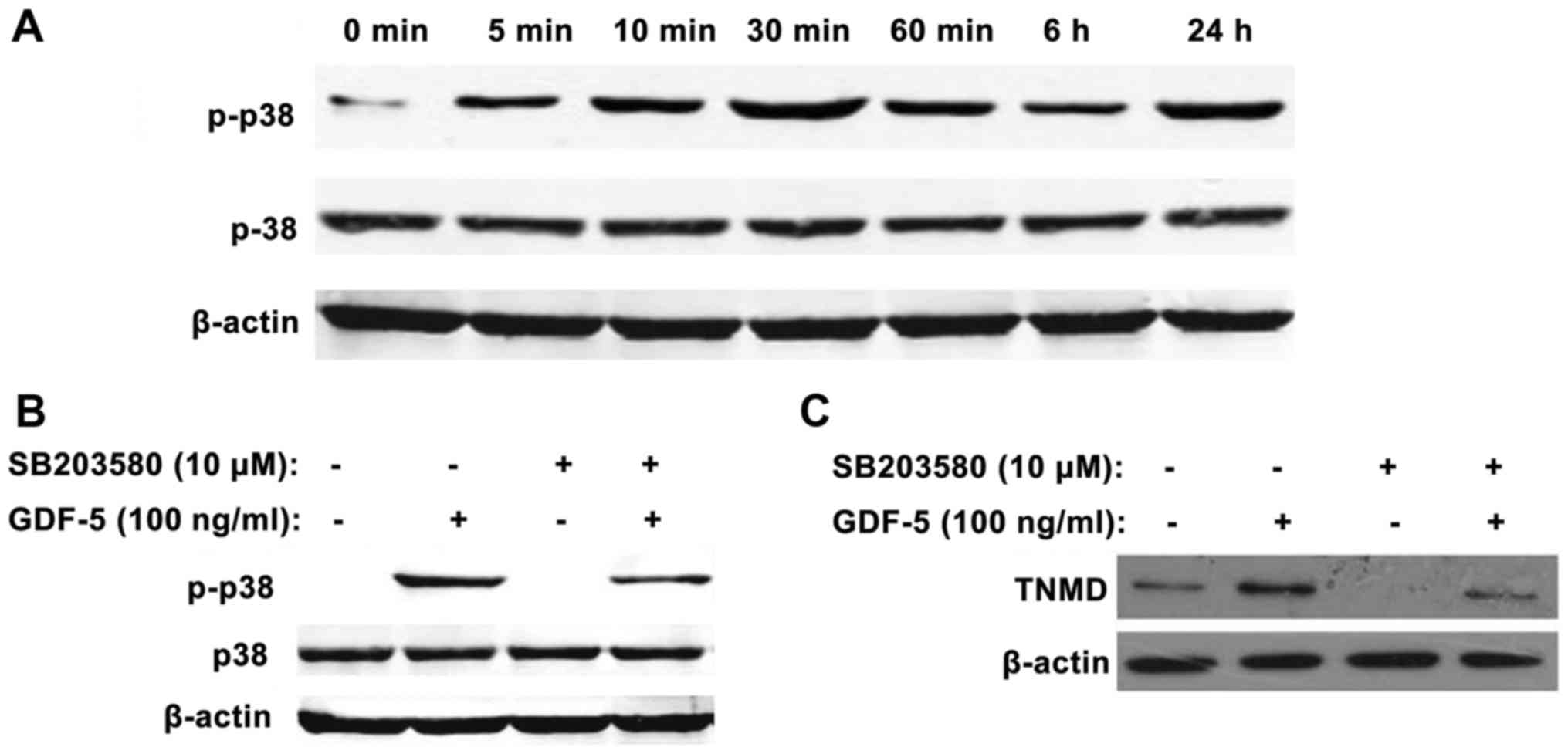Growth differentiation factor‑5 induces tenomodulin expression via phosphorylation of p38 and promotes viability of murine mesenchymal stem cells from compact bone
- Authors:
- Published online on: December 20, 2017 https://doi.org/10.3892/mmr.2017.8325
- Pages: 3640-3646
-
Copyright: © Qu et al. This is an open access article distributed under the terms of Creative Commons Attribution License.
Abstract
Introduction
Damaged tendons heal slowly and rarely regain the structural integrity and mechanical strength of normal, undamaged tendons (1). Tissue engineering may be used to repair tendons (2). Recent research has focused on the use of active mesenchymal cells and growth factors as alternative strategies for tendon repair (3).
Mesenchymal stem cells (MSCs) are adult stem cells that have multilineage differentiation potential (4,5). MSCs are easy to obtain, have low immunogenicity and are associated with fewer ethical issues than embryonic stem cells (6). MSCs are primarily found in the bone marrow; however, stem/progenitor cells with MSC-like features have been reported in various other tissues and organs (7). It has previously been reported that cells isolated from mouse cortical bone exhibit the morphological and immunological phenotype of MSCs, and possess osteogenic, adipogenic and chondrogenic differentiation potentials (8). Therefore, MSCs from murine compact bone may be considered a suitable candidate for tendon bioengineering.
Growth factors are frequently required for the regulation of cell metabolism, cell proliferation, differentiation and extracellular matrix production (9,10). Growth differentiation factor (GDF)-5 is a member of the GDF family, which serves an important role in limb development and maturation (11,12). It is a member of the tumor growth factor (TGF)-β superfamily, which is involved in cell growth and differentiation in embryonic and adult tissues (11). Transfer of the GDF-5 gene into chick embryos enhanced the number of cells in S phase by 53.6% (11), and GDF-5 induced the proliferation of rat adipose-derived MSCs (3). It has previously been reported that GDF-5 gene therapy increases the tensile strength of rat Achilles tendon without inducing bone or cartilage formation within the healed tendon (13). GDF-5 is involved in osteogenic and cartilaginous differentiation (12); however, the role of GDF-5 in musculotendinous differentiation has rarely been reported.
Tenomodulin is primarily expressed in tendons, ligaments and eyes (14), and serves an important role in tendon tissue growth (15). Tenomodulin and chondromodulin I act together as regulators of cell proliferation and differentiation (14). An association between tendon formation and tenomodulin expression has previously been reported (16,17). Deletion of the tenomodulin gene reduced the mitotic activity of tendon cells, and affected the formation and size of collagen fibers (14). In addition, previous studies have demonstrated that tenomodulin is involved in regulation of the tendon maturation process (18,19). Therefore, these results suggest that tenomodulin may have a key role in tendon tissue growth.
p38 mitogen-activated protein kinase (MAPK) is a classical signaling pathway in mammals. p38 signal transduction is involved in cell growth, development, differentiation, apoptosis, and a series of physiological and pathological processes. In addition, deletion of the gene encoding myostatin (alternatively known as GDF-8) affected the expression of tenomodulin via p38 (20). p38 activation is involved in the expression of numerous factors involved in tendon remodeling (21), including tenomodulin (20); however, p38 may be a non-obligate modulator of tenomodulin (22).
Previous literature has suggested the existence of certain associations between the p38 MAPK signaling pathway and tenomodulin expression; therefore, the present study aimed to investigate the effects of GDF-5 on the regulation of tenomodulin expression via the p38 MAPK signaling pathway. These results may improve understanding of the underlying molecular mechanisms involved in tendon repair.
Materials and methods
Animals
C57BL/6 female mice (age, 2–3 weeks; weight, 15–20 g) were purchased from the Laboratory Animal Center of The First Affiliated Hospital of Harbin Medical University (Harbin, China). The mice were maintained at 22±2°C and 40% humidity in a specific pathogen-free room under a 12 h light/dark cycle. The mice were given free access to standard mouse chow and tap water. All procedures and animal experiments were approved by the Animal Care and Use Committee of Harbin Medical University (Harbin, China).
Isolation and culture of MSCs from murine compact bone
MSCs were isolated from compact bones, as previously described (8). Four mice were anaesthetized with 3% sodium pentobarbital (50 mg/kg intraperitoneally), sacrificed by cervical dislocation and placed in a beaker with 100 ml 75% (v/v) ethanol for 3 min. Mice were placed in a 100-mm sterile glass dish and a circular incision was made from the lower part of the abdomen (ventral side), from the shoulder to the middle back. The skin was pulled and the femurs and humeri were cut below the femoral heads and at the axillae. The bones were cleaned of muscles and tendons, and were stored in a sterile glass dish with 5 ml α-minimal essential medium (α-MEM; Hyclone; GE Healthcare Life Sciences, Logan, UT, USA) containing 0.1% (v/v) penicillin/streptomycin (Hyclone; GE Healthcare Life Sciences) and 2% (v/v) fetal bovine serum (FBS; Hyclone; GE Healthcare Life Sciences). The marrow cavity was exposed by severing the epiphyses and was flushed thoroughly with α-MEM until the bone turned pale. The humeri, tibiae and femurs were cut into small sections (~1 mm3) and transferred into a 25-cm2 flask with 3 ml α-MEM containing 10% (v/v) FBS and 0.15% (w/v) collagenase II (Sigma-C-6885; Sigma-Aldrich; Merck KGaA, Darmstadt, Germany). The sections were digested for 1–2 h in a shaking incubator at 37°C and 200 rpm. The digestion was terminated when the sections became loosely attached to each other. The sections were washed ≥3 times and were subsequently transferred into fresh 25-cm2 plastic flasks in α-MEM supplemented with 10% (v/v) FBS and 0.1% (v/v) penicillin/streptomycin. The flask was placed at 37°C in a 5% CO2 incubator. The cultured medium was replaced on day 4. When cells reached 70–80% confluence, cells were dissociated with trypsin-EDTA and passaged at a ratio of 1:3.
Flow cytometric analysis
To identify the surface markers of MSCs from murine compact bone, cells from passages 3–10 were harvested by trypsin digestion and incubated with the following antibodies at room temperature for 30 min: 2.0 µg antibody/1×106 cells/ml fluorescein isothiocyanate (FITC) anti-mouse cluster of differentiation (CD)44 (cat. no. 553133), peridinin chlorophyll protein complex (PerCP) anti-mouse CD45 (cat. no. 561047), phycoerythrin (PE) anti-mouse CD73 (cat. no. 550741) and allophycocyanin (APC) anti-mouse CD90.2 (cat. no. 553007). In addition, cells were incubated with the following isotype control antibodies: 2.0 µg antibody/1×106 cells/ml FITC rat immunoglobulin (Ig)G2b (cat. no. 556923), PerCP rat IgG2b (cat. no. 552991), PE rat IgG2a (cat. no. 555844) and APC rat IgG2a (cat. no. 551139). All antibodies were purchased from BD Biosciences (Franklin Lakes, NJ, USA). MSCs from murine compact bone were identified as exhibiting low expression levels of the hematopoietic stemness marker CD45, and high expression levels of the mesenchymal stemness markers CD44, CD73 and CD90 (23). Flow cytometry was conducted using a FACSCalibur and data were analyzed using Cell Quest™ Pro 5.2.1, (both from BD Biosciences).
Adipogenic differentiation
MSCs from the third passage were seeded in a 24-well plate at a density of 2×104 cells/well, and cultured at 37°C and 5% CO2. When cells reached ~100% confluence, the medium was carefully aspirated from each well and adipogenic induction medium was added, which contained 10−6 M dexamethasone, 0.5 µM isobutylmethylxanthine and 10 ng/ml insulin (Cyagen Biosciences, Santa Clara, CA, USA). α-MEM supplemented with 10% FBS served as the negative control. The medium was replaced every 2–3 days. On day 14, the MSCs that committed to the adipogenic lineage were filled with lipid-rich vacuoles and were identified by staining with Oil red O. The cells were observed under an IX53 light microscope (Olympus Corporation, Tokyo, Japan).
Osteogenic differentiation
MSCs at the third passage were seeded in a 24-well plate at a density of 3×103 cells/well and cultured at 37°C and 5% CO2. When cells were ~60% confluent, the medium was carefully aspirated and osteogenic induction medium containing 10−7 M dexamethasone, 10 mM β-glycerol phosphate and 50 µM ascorbate-2-phosphate (Cyagen Biosciences) was added. α-MEM supplemented with 10% FBS served as the negative control. The medium was replaced every 2–3 days. After 3 weeks of differentiation, the cells were fixed with 4% formalin, stained with Alizarin red and observed under an IX53 light microscope (Olympus Corporation).
Chondrogenic differentiation
MSCs at the third passage were seeded in 15-ml polypropylene culture tubes at a density of 1×106 cells/tube, centrifuged at 150 × g for 5 min at room temperature, and subsequently cultured at 37°C and 5% CO2. The cells were pelleted every 2–3 days and incubated with complete chondrogenic medium containing 10−7 M dexamethasone, 1% insulin-transferrin-sodium selenite, 50 µM ascorbate-2-phosphate, 1 mM sodium pyruvate, 50 µg/ml proline and 20 ng/ml TGF-β3 (Cyagen Biosciences). α-MEM supplemented with 10% FBS served as the negative control. The medium was replaced every 2–3 days. Chondrogenic pellets were harvested after 21 days. Pellets were fixed in 4% formalin and embedded in paraffin for Alcian blue staining, which was used to detect synthesis of proteoglycans by chondrocytes, and observed under a IX53 light microscope (Olympus Corporation).
Cell Counting Kit-8 (CCK-8) assay
A CCK-8 assay (Dojindo Molecular Technologies, Inc., Kumamoto, Japan) was performed to evaluate the effects of GDF-5 on the viability of MSCs. Cells at passage 3 were seeded in 96-well plates at a density of 1×103 cells/well with 100 µl medium, which was replaced every 2 days. To study the concentration kinetics of GDF-5, MSCs were maintained in culture medium containing GDF-5 protein (PeproTech, Inc., Rocky Hill, NJ, USA) at 0, 1, 10, 100 and 1,000 ng/ml at 37°C for 4 days. In this experiment, 100 ng/ml GDF-5 exhibited the most significant difference compared with other concentrations tested; therefore, 100 ng/ml GDF-5 was selected for subsequent experiments. Cells were cultured with or without 100 ng/ml GDF-5 and were analyzed after 3, 6, 9 and 12 days. CCK-8 was added and the plates were incubated for 1–2 h. The absorbance was measured at a wavelength of 490 nm using a Synergy H4 microplate reader (BioTek Instruments, Inc., Winooski, VT, USA) and cell viability was calculated.
Reverse transcription-quantitative polymerase chain reaction (RT-qPCR)
MSCs at the third passage were seeded in a 6-well plate at a density of 5×104 cells/well and cultured at 37°C and 5% CO2. To study the concentration kinetics of GDF-5, cells were maintained in culture medium supplemented with GDF-5 at 0, 1, 10, 100 and 1,000 ng/ml at 37°C for 4 days. On day 4, cells were harvested for RNA extraction. Total RNA was extracted using TRIzol reagent (Invitrogen; Thermo Fisher Scientific, Inc., Waltham, MA, USA). RNA purity was determined via absorbance at 260 and 280 nm (A260/280). cDNA synthesis was performed using the Accupower RocketScript RT PreMix (Bioneer Corporation, Daejeon, Korea) according to the manufacturer's protocol. Using the SYBR®-Green Real-Time PCR master mix kit (Tiangen Biotech Co., Ltd., Beijing, China), qPCR was performed with 25 µl SYBR®-Green master mix and the following primers: Tenomodulin, forward 5′-CACCAGACAAGCAAGCGAG-3′, reverse 5′-GCAGTAGGGGTATGGGTAGTAG-3′; and GAPDH, forward 5′-AAACCCATCACCATCTTCCA-3′ and reverse 5′-GTGGTTCACACCCATCACAA-3′, on a 7500 Real-Time PCR system (Applied Biosystems, Thermo Fisher Scientific, Inc.). Cycling conditions were as follows: Initial denaturation at 95°C for 2 min, followed by 40 cycles of denaturation at 95°C for 30 sec, annealing at 60°C for 30 sec and extension at 72°C for 30 sec. The quantification cycle (Cq) value was defined as the number of cycles in which the fluorescence signal exceeded the detection threshold value. The 2−ΔΔCq quantification method (24) was used to quantify PCR results and the values were normalized to GAPDH.
Western blotting
MSCs at the third passage were seeded in a 6-well plate at a density of 5×104 cells/well and cultured at 37°C and 5% CO2. To determine the effects of GDF-5 on the activation of p38, cells were synchronized and stimulated with 100 ng/ml GDF-5 for 0, 5, 10, 30 and 60 min, and 6 and 24 h, at 37°C; subsequently, the expression levels of relevant proteins were detected by western blotting.
Alternatively, MSCs at the third passage were seeded in a 6-well plate at a density of 5×104 cells/well and cultured at 37°C and 5% CO2. Cells were synchronized and pre-stimulated with 10 µM SB203580 (Tocris Bioscience, Bristol, UK; an inhibitor of p38 MAPK) at 37°C for 1 h. The control group was treated with an equivalent volume of 0.1% dimethyl sulfoxide. The cells were then treated with 100 ng/ml GDF-5 for 30 min, which resulted in optimal activation of GDF-5. The expression levels of the relevant proteins were detected by western blotting 30 min after GDF-5 induction.
Cell lysates were prepared using radioimmunoprecipitation assay buffer (Beyotime Institute of Biotechnology, Haimen, China) containing 0.1 M phenylmethylsulfonyl fluoride (Beyotime Institute of Biotechnology), according to the manufacturer's protocol. Following extraction, the protein concentrations of lysates were determined by a bicinchoninic acid assay (Beyotime Institute of Biotechnology). Equal quantities of protein (80 µg) were separated by 10% SDS-PAGE prior to transfer onto nitrocellulose membranes (Invitrogen; Thermo Fisher Scientific, Inc.). Membranes were blocked with 5% non-fat dry milk at 4°C overnight. Membranes were subsequently incubated with primary antibodies against tenomodulin (1:1,000; ab203676; Abcam, Cambridge, UK), p38, phosphorylated (p)-p38 (1:1,000; B0798 and A7179; Assay Biotechnology Company, Inc., Sunnyvale, CA, USA) and β-actin (1:1,000; SC47778; OriGene Technologies, Inc., Beijing, China) at 4°C overnight. Following washing with PBS, membranes were incubated with a horseradish peroxidase-conjugated IgG secondary antibody (1:5,000; ZDR-5118; ZSGB-Bio Co., Ltd.) for 2 h. Proteins were detected using an Enhanced Chemiluminescence reagent (Pierce; Thermo Fisher Scientific, Inc.).
Statistical analysis
Data are expressed as the mean ± standard deviation of three independent experiments. Statistical significance was evaluated by a Student's t-test or one-way analysis of variance with Student-Newman-Keuls post hoc test. All statistical analyses were conducted using SPSS version 12.0 software (SPSS, Inc., Chicago, IL, USA). P<0.05 was considered to indicate a statistically significant difference.
Results
Identification of MSCs from murine compact bone
Cells were observed growing from the bone specimens after 48 h cultivation (Fig. 1A). The bone specimens were removed from the flask after the third passage; Fig. 1B demonstrates the distribution of the cells observed in the culture flask without bone specimens. After 96 h culture, cells were observed surrounding the bone pieces, adhering to the plate and exhibited a radial growth typical of MSCs (Fig. 1C). After the third generation, cell morphology was stable and proliferation was rapid (Fig. 1D).
Flow cytometric analysis revealed that MSCs from murine compact bone had a classical MSC phenotype, as they exhibited low expression of the hematopoietic stem marker CD45 (Fig. 2A), and high expression of the mesenchymal stem markers CD44 (Fig. 2B), CD73 (Fig. 2C) and CD90 (Fig. 2D).
As shown in Fig. 3, MSCs isolated from murine compact bone were pluripotent and exhibited adipogenic, osteoblastic and chondrocyte differentiation potentials.
Effects of concentration and duration of GDF-5 treatment on MSC viability
Compared with the control group (0 ng/ml GDF-5), treatment with 10–1,000 ng/ml GDF-5 enhanced cell viability (10 ng/ml, +16.7%; 100 ng/ml, +36.9%; 1,000 ng/ml, +23.2%; P<0.01; Fig. 4A); the greatest difference was achieved using 100 ng/ml GDF-5. When determining the effects of various GDP-5 treatment durations, results revealed that GDF-5 enhanced cell viability from day 3 to 9 compared with the control group (P<0.01; Fig. 4B), and reached a peak on day 6 (day 3, +25.6%; day 6, +56.6%; day 9, +50.5%). There was no difference compared with the control on day 12 (P>0.05).
Effects of GDF-5 on tenomodulin mRNA expression in MSCs from compact bone
Compared with the control group (0 ng/ml GDF-5), the mRNA expression levels of tenomodulin were increased following treatment with 100 ng/ml GDF-5 (+249%; P<0.05; Fig. 5). However, there was no difference in expression after treatment with 1, 10 or 1,000 ng/ml GDF-5 (P>0.05 vs. 0 ng/ml GDF-5; Fig. 5).
GDF-5 treatment increases the protein expression of tenomodulin via phosphorylation of p38 in MSCs from murine compact bone
Treatment of MSCs with GDF-5 increased the protein expression levels of p-p38; this increase was initially observed after 5 min, reached a peak at 30 min and declined from 60 min to 24 h (Fig. 6A), compared with the control group (0 ng/ml GDF-5). These results suggested that p38 may be activated by GDF-5, thus increasing the expression levels of p-p38.
MSCs were cultured for 60 min with SB203580 prior to culture with GDF-5 for 30 min. In the control group, the expression levels of p-p38 were markedly enhanced by GDF-5. Compared with the control group, the expression of p38 was not affected by SB203580 treatment; however, the expression of p-p38 was markedly inhibited in GDF-5-treated cells by SB203580 (Fig. 6B).
Compared with the control group, the protein expression levels of tenomodulin were enhanced following 4 days of incubation with GDF-5. However, when comparing the GDF-5 + SB203580 group with the GDF-5 treatment group, the expression of tenomodulin was suppressed by 1 h pretreatment with 10 µM SB203580 (Fig. 6C).
Discussion
GDF-5 serves a role in tissue development and tenomodulin serves an important role in the development of tendons; however, the effects of GDF-5 on MSC viability and its use in tendon bioengineering remain to be elucidated. The present study aimed to investigate the effects of GDF-5 on viability and tenomodulin expression of MSCs from murine compact bone. GDF-5 treatment promoted MSC viability and increased the protein expression levels of tenomodulin in MSCs from murine compact bone. Therefore, the use of GDF-5 may be of value for tendon engineering.
Previous studies (25,26) have investigated bone marrow-derived MSC extraction, screening, purification, culture and applications. However, the culture of mouse bone marrow-derived MSCs has certain disadvantages. Notably, mouse MSC isolation often yields a low number of stem cells (27): ~1 per million (28). In addition, when the whole bone marrow adherence method is utilized, mouse bone marrow hematopoietic stem cells are difficult to remove due to their strong adherence ability, which markedly affects results. Furthermore, the methods of separation are complex and expensive (27,28). The present study suggested that MSCs may be successfully isolated from murine compact bone. To achieve optimal results, bone chips should be ~1 mm3, as large chips may impair cell migration, whereas small chips may result in cells escaping during digestion. However, the optimization of isolation and purification of MSCs from murine compact bone remains to be achieved.
Stem cells are required for tendon tissue engineering, and these cells have to be in adequate numbers (29). During preparation, stem cells may suffer from apoptosis due to alterations in the physical and chemical environment. Therefore, induction of stem cells may strengthen their proliferative activity, in order to improve the success rate of tendon tissue engineering (29). Park et al (3) reported that GDF-5 may induce the proliferation of rat adipose-derived MSCs. An MTT assay revealed that 10 ng/ml GDF-5 enhanced the proliferation of cells, and 100 ng/ml GDF-5 achieved greater effects (3). Although 1,000 ng/ml GDF-5 additionally improved cell viability, it was limited (3). These findings were concordant with the results of the present study, which used the CCK-8 method to analyze cell viability. Results revealed that cell viability was not increased following treatment with 1 ng/ml GDF-5; however, viability was increased with 10 ng/ml GDF-5 and peaked using 100 ng/ml GDF-5. Conversely, viability was lower following treatment with 1,000 ng/ml GDF-5. These results suggested that there was a dose-dependent association between GDF-5 and MSC viability.
In the time-effect experiments, cell viability was greatest on day 6 and declined by day 9. The viability of GDF-5-treated cells was similar to control cells by day 12. This may be due to contact inhibition (cells growing to confluence) and the availability of nutrients. In the present study, a 2D culture method was utilized, thus limiting the culture space. However, the results demonstrated a time-dependent association between GDF-5 treatment and MSC viability.
Treatment with 100 ng/ml GDF-5 may enhance tenomodulin expression levels in adipose tissue-derived MSCs (3) and in MSCs cultured on scaffolds (30); these previous findings supported the results of the present study. Therefore, it may be suggested that in the process of constructing tissue-engineered tendons, the presence of GDF-5 in seeded cells may induce tendon cell differentiation.
GDF-5 is known to activate p38-MAPK (31,32) and extracellular signal-regulated kinase 1/2 (33) signaling pathways, which are involved in cell growth, proliferation and death. In addition, a mouse model demonstrated that knockdown of GDF-5 resulted in reduced p38 phosphorylation (34). p38 activation affects the expression of numerous factors involved in tendon remodeling (21), including tenomodulin (20). However, p38 may be a non-obligate modulator of tenomodulin (22). The present study revealed that GDF-5 treatment increased tenomodulin expression; however, pretreatment with the p38-specific inhibitor, SB203580, resulted in reduced tenomodulin expression. These results suggested that p38 may be involved in GDF-5-mediated MSC viability. The present study did not investigate the underlying molecular mechanisms of this process. Additional studies are required to determine this association and whether it may be used for tendon bioengineering.
In conclusion, GDF-5 treatment promoted MSC viability, and increased the protein expression levels of tenomodulin via phosphorylation of p38 in MSCs from murine compact bones. These results may aid the future development of tendon bioengineering.
Acknowledgements
The present study was supported by grants from the National Natural Science Foundation of China (grant no. 30500508) and the Natural Science Foundation of Heilongjiang Province of China (grant no. D201112).
References
|
Sharma P and Maffulli N: Biology of tendon injury: Healing, modeling, and remodeling. J Musculoskelet Neuronal Interact. 6:181–190. 2006.PubMed/NCBI | |
|
DeFranco MJ, Derwin K and Iannotti JP: New therapies in tendon reconstruction. J Am Acad Orthop Surg. 12:298–304. 2004. View Article : Google Scholar : PubMed/NCBI | |
|
Park A, Hogan MV, Kesturu GS, James R, Balian G and Chhabra AB: Adipose-derived mesenchymal stem cells treated with growth differentiation factor-5 express tendon-specific markers. Tissue Eng Part A. 16:2941–2951. 2010. View Article : Google Scholar : PubMed/NCBI | |
|
Zhou S, Yates KE, Eid K and Glowacki J: Demineralized bone promotes chondrocyte or osteoblast differentiation of human marrow stromal cells cultured in collagen sponges. Cell Tissue Bank. 6:33–44. 2005. View Article : Google Scholar : PubMed/NCBI | |
|
Chamberlain G, Fox J, Ashton B and Middleton J: Concise review: Mesenchymal stem cells: Their phenotype, differentiation capacity, immunological features, and potential for homing. Stem Cells. 25:2739–2749. 2007. View Article : Google Scholar : PubMed/NCBI | |
|
Howard D, Buttery LD, Shakesheff KM and Roberts SJ: Tissue engineering: Strategies, stem cells and scaffolds. J Anat. 213:66–72. 2008. View Article : Google Scholar : PubMed/NCBI | |
|
da Silva Meirelles L, Chagastelles PC and Nardi NB: Mesenchymal stem cells reside in virtually all post-natal organs and tissues. J Cell Sci. 119:2204–2213. 2006. View Article : Google Scholar : PubMed/NCBI | |
|
Zhu H, Guo ZK, Jiang XX, Li H, Wang XY, Yao HY, Zhang Y and Mao N: A protocol for isolation and culture of mesenchymal stem cells from mouse compact bone. Nat Protoc. 5:550–560. 2010. View Article : Google Scholar : PubMed/NCBI | |
|
Oshin AO, Caporali E, Byron CR, Stewart AA and Stewart MC: Phenotypic maintenance of articular chondrocytes in vitro requires BMP activity. Vet Comp Orthop Traumatol. 20:185–191. 2007.PubMed/NCBI | |
|
Aspenberg P: Stimulation of tendon repair: Mechanical loading, GDFs and platelets. A mini-review. Int Orthop. 31:783–789. 2007. View Article : Google Scholar : PubMed/NCBI | |
|
Buxton P, Edwards C, Archer CW and Francis-West P: Growth/differentiation factor-5 (GDF-5) and skeletal development. J Bone Joint Surg Am. 83-A Suppl 1:S23–S30. 2001. | |
|
Daans M, Luyten FP and Lories RJ: GDF5 deficiency in mice is associated with instability-driven joint damage, gait and subchondral bone changes. Ann Rheum Dis. 70:208–213. 2011. View Article : Google Scholar : PubMed/NCBI | |
|
Bolt P, Clerk AN, Luu HH, Kang Q, Kummer JL, Deng ZL, Olson K, Primus F, Montag AG, He TC, et al: BMP-14 gene therapy increases tendon tensile strength in a rat model of Achilles tendon injury. J Bone Joint Surg Am. 89:1315–1320. 2007. View Article : Google Scholar : PubMed/NCBI | |
|
Docheva D, Hunziker EB, Fässler R and Brandau O: Tenomodulin is necessary for tenocyte proliferation and tendon maturation. Mol Cell Biol. 25:699–705. 2005. View Article : Google Scholar : PubMed/NCBI | |
|
Aslan H, Kimelman-Bleich N, Pelled G and Gazit D: Molecular targets for tendon neoformation. J Clin Invest. 118:439–444. 2008. View Article : Google Scholar : PubMed/NCBI | |
|
Shukunami C, Takimoto A, Miura S, Nishizaki Y and Hiraki Y: Chondromodulin-I and tenomodulin are differentially expressed in the avascular mesenchyme during mouse and chick development. Cell Tissue Res. 332:111–122. 2008. View Article : Google Scholar : PubMed/NCBI | |
|
Shukunami C, Takimoto A, Oro M and Hiraki Y: Scleraxis positively regulates the expression of tenomodulin, a differentiation marker of tenocytes. Dev Biol. 298:234–247. 2006. View Article : Google Scholar : PubMed/NCBI | |
|
Pisani DF, Pierson PM, Massoudi A, Leclerc L, Chopard A, Marini JF and Dechesne CA: Myodulin is a novel potential angiogenic factor in skeletal muscle. Exp Cell Res. 292:40–50. 2004. View Article : Google Scholar : PubMed/NCBI | |
|
Shukunami C and Hiraki Y: Chondromodulin-I and tenomodulin: The negative control of angiogenesis in connective tissue. Curr Pharm Des. 13:2101–2112. 2007. View Article : Google Scholar : PubMed/NCBI | |
|
Mendias CL, Bakhurin KI and Faulkner JA: Tendons of myostatin-deficient mice are small, brittle, and hypocellular. Proc Natl Acad Sci USA. 105:pp. 388–393. 2008; View Article : Google Scholar : PubMed/NCBI | |
|
Popov C, Burggraf M, Kreja L, Ignatius A, Schieker M and Docheva D: Mechanical stimulation of human tendon stem/progenitor cells results in upregulation of matrix proteins, integrins and MMPs and activation of p38 and ERK1/2 kinases. BMC Mol Biol. 16:62015. View Article : Google Scholar : PubMed/NCBI | |
|
Schwartz AJ, Sarver DC, Sugg KB, Dzierzawski JT, Gumucio JP and Mendias CL: p38 MAPK signaling in postnatal tendon growth and remodeling. PLoS One. 10:e01200442015. View Article : Google Scholar : PubMed/NCBI | |
|
Dominici M, Le Blanc K, Mueller I, Slaper-Cortenbach I, Marini F, Krause D, Deans R, Keating A, Prockop Dj and Horwitz E: Minimal criteria for defining multipotent mesenchymal stromal cells. The International Society for Cellular Therapy position statement. Cytotherapy. 8:315–317. 2006. View Article : Google Scholar : PubMed/NCBI | |
|
Livak KJ and Schmittgen TD: Analysis of relative gene expression data using real-time quantitative PCR and the 2(-Delta Delta C(T)) method. Methods. 25:402–408. 2001. View Article : Google Scholar : PubMed/NCBI | |
|
Pereira RF, Halford KW, O' Hara MD, Leeper DB, Sokolov BP, Pollard MD, Bagasra O and Prockop DJ: Cultured adherent cells from marrow can serve as long-lasting precursor cells for bone, cartilage, and lung in irradiated mice. Proc Natl Acad Sci USA. 92:pp. 4857–4861. 1995; View Article : Google Scholar : PubMed/NCBI | |
|
Prockop DJ: Marrow stromal cells as stem cells for non hematopoietic tissues. Science. 276:71–74. 1997. View Article : Google Scholar : PubMed/NCBI | |
|
Varma MJ, Breuls RG, Schouten TE, Jurgens WJ, Bontkes HJ, Schuurhuis GJ, van Ham SM and van Milligen FJ: Phenotypical and functional characterization of freshly isolated adipose tissue-derived stem cells. Stem Cells Dev. 16:91–104. 2007. View Article : Google Scholar : PubMed/NCBI | |
|
Phinney DG, Kopen G, Isaacson RL and Prockop DJ: Plastic adherent stromal cells from the bone marrow of commonly used strains of inbred mice: Variations in yield, growth, and differentiation. J Cell Biochem. 72:570–585. 1999. View Article : Google Scholar : PubMed/NCBI | |
|
Yin Z, Chen X, Chen JL and Ouyang HW: Stem cells for tendon tissue engineering and regeneration. Expert Opin Biol Ther. 10:689–700. 2010. View Article : Google Scholar : PubMed/NCBI | |
|
Farng E, Urdaneta AR, Barba D, Esmende S and McAllister DR: The effects of GDF-5 and uniaxial strain on mesenchymal stem cells in 3-D culture. Clin Orthop Relat Res. 466:1930–1937. 2008. View Article : Google Scholar : PubMed/NCBI | |
|
Nakamura K, Shirai T, Morishita S, Uchida S, Saeki-Miura K and Makishima F: p38 mitogen-activated protein kinase functionally contributes to chondrogenesis induced by growth/differentiation factor-5 in ATDC5 cells. Exp Cell Res. 250:351–363. 1999. View Article : Google Scholar : PubMed/NCBI | |
|
Coleman CM and Tuan RS: Functional role of growth/differentiation factor 5 in chondrogenesis of limb mesenchymal cells. Mech Dev. 120:823–836. 2003. View Article : Google Scholar : PubMed/NCBI | |
|
Watanabe H, de Caestecker MP and Yamada Y: Transcriptional cross-talk between Smad, ERK1/2 and p38 mitogen-activated protein kinase pathways regulates transforming growth factor-beta-induced aggrecan gene expression in chondrogenic ATDC5 cells. J Biol Chem. 276:14466–14473. 2001. View Article : Google Scholar : PubMed/NCBI | |
|
Zaidi SH, Huang Q, Momen A, Riazi A and Husain M: Growth differentiation factor 5 regulates cardiac repair after myocardial infarction. J Am Coll Cardiol. 55:135–143. 2010. View Article : Google Scholar : PubMed/NCBI |



